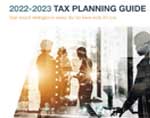With the pandemic behind us and a red-hot summer in full swing, many of your company’s employees may be finally rediscovering the uninhibited joys of vacation.
Your workers might be having so much fun, in fact, that they might highly value being able to buy even more paid time off (PTO) as an employee benefit. Such a perk could also catch the attention of job candidates. Well, it’s all possible if your business sponsors a cafeteria plan (sometimes referred to as a Section 125 plan).
Compliance requirements
A “PTO buying” feature under a cafeteria plan allows employees to prospectively elect, during the annual open enrollment period before the beginning of each plan year, to buy additional PTO beyond that which they’d otherwise receive from their employer. These purchases typically occur via salary reductions or flex credits.
The rules for PTO buying under a cafeteria plan are complex, but let’s review a couple of the most critical compliance requirements. First, the PTO buying feature must not defer compensation from one plan year to the next. This means that PTO bought under the cafeteria plan generally must be used, cashed out or forfeited by the end of the plan year. Employees can’t carry over the PTO for use in a later plan year.
If you opt to permit employees to cash out unused PTO at the end of the plan year, you’ll need to clearly inform them that these dollars will be included in their taxable income. Employers can also choose to set up the plan feature so that employees simply forfeit unused PTO when the plan year ends. However, before going this route, you should check into whether your state’s laws restrict such forfeitures.
Second, something called the “ordering rule” applies. The IRS refers to additional PTO bought through a cafeteria plan as “elective” PTO. The ordering rule requires employees to use nonelective PTO before elective PTO. Thus, they can use their purchased PTO only after exhausting all PTO earned under normal compensation.
The practical consequence of the ordering rule is that employees must expend all their PTO — whether elective or nonelective — to prevent a cash-out or forfeiture of any elective PTO at the end of the plan year. Thus, a PTO buying feature under a cafeteria plan may not be a good fit for businesses with PTO policies that allow employees to carry over unused nonelective PTO to future years. And, again, a buying feature might conflict with state laws that prohibit forfeiture of unused PTO.
An appealing benefit
Being able to buy additional PTO may not only be an appealing way to give employees more “beach time,” but also (and on a more serious note) a means of giving staff members more flexibility to care for their mental health. However, as mentioned, the rules involved are complex, so you’ll need to design and manage this cafeteria-plan feature carefully. Contact us for further information and assistance.
© 2023




